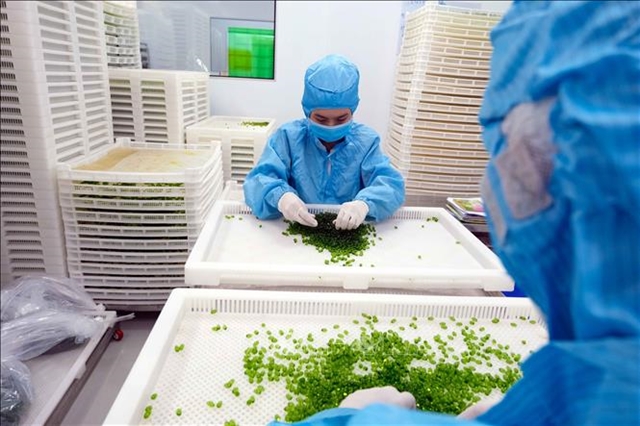Pharmaceutical companies urged to invest in R&D, improve competitiveness

The Ministry of Health estimated the market at US$6.9 billion in 2021 while BMI Research forecast the market to reach $16.1 billion in 2026 with a compound growth rate of up to 11 per cent.
 |
| ADC Pharma in Cần Thơ Province. As the domestic pharmaceutical market holds a lot of potential, local producers are urged to improve their competitiveness for expansion. — VNA/VNS Photo Thanh Liêm |
HÀ NỘI — It is critical for pharmaceutical companies to improve competitiveness with a focus on research and development (R&D), production technology and digitalisation.
According to experts, this will help them expand their shares in the domestic market which remains being dominated by imported drugs and extend their international reach.
Việt Nam’s pharmaceutical market has significant potential. The Ministry of Health estimated the market at US$6.9 billion in 2021 while BMI Research forecast the market to reach $16.1 billion in 2026 with a compound growth rate of up to 11 per cent.
According to Nguyễn Diệu Hà, general secretary and office chief of the Vietnam Pharmaceutical Companies Association (VNPCA), there are 55 foreign-invested pharmaceutical companies in Việt Nam as of the end of 2022, 228 companies meeting World Health Organisation – Good Manufacturing Practice (WTO-GMP) and 12 meeting high GMP standards of the EU, Japan, PIC/S and TCA.
These figures show that the pharmaceutical industry of Việt Nam has made a significant improvement since 2017 when there were only two companies meeting GMP.
Still, the domestic pharmaceutical market is a playground for foreign pharmaceutical companies. Hà pointed out that domestic drug production only accounted for 46 per cent of the total spending on drugs of local people in the 2015-21 period. Although this rate increased significantly compared to the rate of 17 per cent in the 2001-11 period, it was still much lower than the world average.
The domestic pharmaceutical industry has not been able to produce specific drugs, only drugs for the treatment of common and chronic diseases. Made-in-Việt Nam pharmaceutical products are mostly anti-infective (32.54 per cent), antipyretic and analgesic (15.5 per cent) and vitamins and minerals (6.55 per cent).
Most essential drugs must still be imported. Domestic GMP-WHO factories mainly produce generic drugs (copies of brand-name drugs).
Lê Văn Truyền, former deputy minister of Health, said Việt Nam’s pharmaceutical industry does not have a strong and modern national R&D centre and lacks international-level clinical trial and biological research centres. In addition, there is no separate industrial park for pharmaceutical production with a complete ecosystem.
Most pharmaceutical companies are of small and medium sizes with limited financial capacity and have not yet formed national-scale pharmaceutical corporations, he said.
Truyền said a majority of domestic pharmaceutical companies lacked resources to exploit the domestic market. The goal of providing 80 per cent of the market demand for pharmaceutical products would be very difficult to achieve if no breakthroughs were made, he said.
Tạ Mạnh Hùng, Deputy Director of the ministry’s Drug Administration of Việt Nam, said that domestic pharmaceutical producers are mostly of small scale, there are few domestically-produced products, the content of science and technology in products is not high.
Those are limitations of the domestic pharmaceutical industry which are highlighted during the COVID-19 pandemic, he said.
Potentials
As in many other developing countries, Vietnamese spending on medicines is increasing, an inevitable trend when incomes improve along with rapid urbanisation.
According to Hà, each Vietnamese spends an average of $73 on medicines in 2021, up from just $6.7 in 2002. With a population of around 100 million, of which, people aged from 65 and over account for 11.9 per cent, the spending on drugs is anticipated to grow at a faster pace, especially after the COVID-19 pandemic which makes people more concerned about health issues.
Under the pharmaceutical industry development programme to 2030 with a vision to 2040 which the Government approved in March, Việt Nam set a goal that by 2025, domestically-produced drugs account for 75 per cent of the market consumption volume and 60 per cent of the value, and by 2030 80 per cent and 70 per cent, respectively.
In addition, Việt Nam aimed to become a high-value pharmaceutical production centre of the region with an export value of $1 billion.
To achieve these targets, the core issue is that domestic producers must improve their competitiveness in line with the development orientations of the pharmaceutical industry, Truyền said.
Truyền pointed out that drug producers around the world have changed their market access strategies from promoting products to supporting the State agencies in disease control and proactively providing healthcare services. The digital transformation process helps a lot in decision-making, which domestic drug producers could learn from.
Notably, the pharmaceutical industry has increasing requirements for information transparency, including management regulation, registration records and research data. Big organisations also require regulations on data integrity/truthfulness in all stages from testing to production and distribution.
Accordingly, Vietnamese drug producers must pay special attention to transparency to increase competitiveness in both home and foreign markets, Truyền said.
The Government must create an open and favourable legal environment so that local producers could go together for mutual development. — VNS








